

The
Research Project
The Study Area
Background Information
Tools Of The Trade
A Day In The Life Of . . .
The Weekend, December 8 & 9, 2001
Sunrise In The Forest
Walking through the forest at dawn is an entirely different
experience than walking through it at dusk. At dusk as 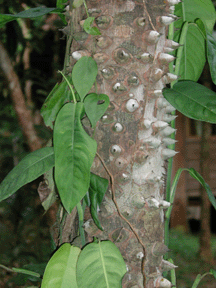 the
sun sets there is a dramatic change in the way the forest sounds. Rather
suddenly “day sounds” are replaced with “night sounds” and the volume increases.
It is as if someone, tired of the CD that has been playing all day, puts
a new one in the player and cranks the volume—switching from soothing
background music to rock-and-roll!
the
sun sets there is a dramatic change in the way the forest sounds. Rather
suddenly “day sounds” are replaced with “night sounds” and the volume increases.
It is as if someone, tired of the CD that has been playing all day, puts
a new one in the player and cranks the volume—switching from soothing
background music to rock-and-roll!
Walking ever so slowly at dusk while the forest darkens around you is a little unnerving. Knowing you are losing your primary sense—sight, and now must rely entirely on your inferior senses of hearing, smell and touch makes you feel less secure. As humans, we are not meant to be out after dark but instead, snug and safe in our shelters with the doors closed and the wild, unknown night shut out.
Being present when the forest wakes up in the morning however is an entirely different experience. With each carefully placed step the forest becomes lighter and your heart is uplifted. The shadows become more and more defined and there is definite a sense of well-being.
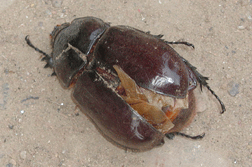 The
crescendo of insect hum that begins at dusk settles back into soft background
noise at dawn until it is barely noticeable. The bats make their final flights
and settle in for the day’s rest and the birds begin to call to one another
across the canopy above. While it seems as though twilight lasts a long
time, morning light comes quickly. Looking up through the canopy and watching
the mist rise through the sunlight is beautiful.
The
crescendo of insect hum that begins at dusk settles back into soft background
noise at dawn until it is barely noticeable. The bats make their final flights
and settle in for the day’s rest and the birds begin to call to one another
across the canopy above. While it seems as though twilight lasts a long
time, morning light comes quickly. Looking up through the canopy and watching
the mist rise through the sunlight is beautiful.
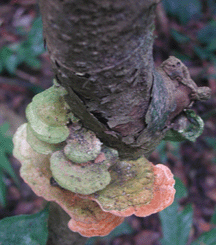 Saturday
morning Lindsay, George and Samuel picked us up at 5:00 AM for the morning
monkey survey. We walked the same trail that Lindsay and Samuel walked a
week ago and spotted both mona and spot nosed monkeys. She was optimistic
that we would find monkeys this morning. Unfortunately we didn’t see or
hear any. That has been our luck so far except for the occasional group
of monas that have been heard not far from camp. We haven’t heard or seen
any Roloways yet. Now we understand why Lindsay took us to the zoo the first
day to see the captured Roloway. It may well be the only one we see.
Saturday
morning Lindsay, George and Samuel picked us up at 5:00 AM for the morning
monkey survey. We walked the same trail that Lindsay and Samuel walked a
week ago and spotted both mona and spot nosed monkeys. She was optimistic
that we would find monkeys this morning. Unfortunately we didn’t see or
hear any. That has been our luck so far except for the occasional group
of monas that have been heard not far from camp. We haven’t heard or seen
any Roloways yet. Now we understand why Lindsay took us to the zoo the first
day to see the captured Roloway. It may well be the only one we see.
Adjustment
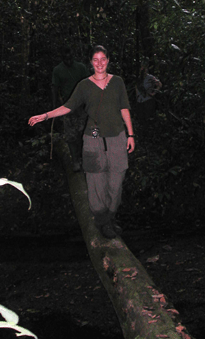 We
are adjusting to the forest walks. Just a few days ago it seemed impossible
to walk without making a sound. Every vine seemed to trip us and every leaf
under our boots conspired to make noise. When jumping over streams, we seemed
to miss the other side of the bank more often than not, landing with a splash
just short of land. Climbing over down trees, we looked less than graceful
as we watched Lindsay and Samuel up ahead of us moving as if the same objects
simply moved out their way as they passed by.
We
are adjusting to the forest walks. Just a few days ago it seemed impossible
to walk without making a sound. Every vine seemed to trip us and every leaf
under our boots conspired to make noise. When jumping over streams, we seemed
to miss the other side of the bank more often than not, landing with a splash
just short of land. Climbing over down trees, we looked less than graceful
as we watched Lindsay and Samuel up ahead of us moving as if the same objects
simply moved out their way as they passed by.
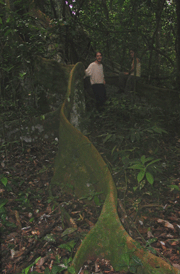 Today
however, we have found a bit of our “jungle sense”. We walk more quietly,
fall into the water less often, and climb over and under things without
getting some piece of hair or clothing caught on something.
Today
however, we have found a bit of our “jungle sense”. We walk more quietly,
fall into the water less often, and climb over and under things without
getting some piece of hair or clothing caught on something.
Could It Be Any Worse?
Today we did another set of veg plots. The first one went off without a hitch. The location surrounded a tree where Lindsay had seen monkeys. The second, random plot, was a different story.
Lindsay had randomly selected the location before going out. As we were finishing up the “non-focal species” plot, she laughed and said,” I hope the random is not up that hill. That would be a really tough one!”
Well guess what? The plot was right smack in the middle of the most difficult part of the hill—48 paces directly uphill. Now it is one thing walking on the trail, and it is another to be climbing up a muddy, slippery jungle hill where it is impossible to move up without using the branches, vines, and roots for support. The only problem is, any one of them could be a snake! Even John and Samuel had a bit of a tough time.
John and Samuel are being trained on the equipment and data sheets so that they can continue doing the transects and veg plots after Lindsay leaves in a few weeks. We had a fun time working out the details and teaching each other how to take the data.
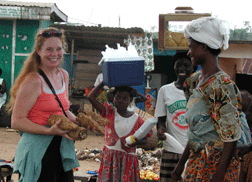 The
Market
The
Market
After our survey and veg plot we traveled to Elubo to buy any fresh produce we could find. Michael and Lindsay managed to find enough to keep our meals enjoyable. We would be simply lost without Michael’s handiwork in the kitchen each evening. We took the opportunity to look around the market and talk with the women selling their wares.
Green Mambas
Lindsay and Samuel went out in the afternoon to walk the trail that they had walked the second day with Kevin and Michael. It was a good choice as they saw monas and spot nosed monkeys and even heard Roloways.
Mostly, they were excited about the two (not one, but two) green mambas they saw. Green mambas are reportedly one of the most deadly of venomous snakes found in Africa. Unbeknownst to them they had been standing by a tree listening for the monkeys in which the mambas had been resting. As Lindsay and Samuel moved away they could see the snakes moving through the trees—all five feet of them. Eventually the snakes dropped to the ground where Samuel and Lindsay lost sight of them. They decided this would be a good time to keep moving down the trail. Both were a little horrified to realize that they had been standing so close to such deadly animals. Of course for the rest of us who had just begun to come to terms with our fear of encountering snakes…well this has set us back a bit!
Forest Elephants
John reports that the forest elephants have been in the area recently. During the dry season they move down from the upper portions of the park. While out walking yesterday he saw piles of fresh dung and the markings the elephants make when they rub up against trees as they pass through the forest. Sunday morning they could be heard back behind the research station where Lindsay stays. Walking these forests it is unimaginable that animals as large as elephants live here. Forest elephants are slightly smaller than those that live in savannah areas but they are just as dangerous. You don’t want to surprise one in the forest.
Sunday we got to see the presence of river elephants ourselves. We walked a long transect, 3.7k and just past the halfway point, we saw an elephant track and a place where they had come down a slope. Later we saw their dung. Lindsay said it was fresh because nothing was sprouting in it yet.
The walk was challenging. We joked that it was too flat, there were too few streams to cross, and the trail was too well marked. Of course, we were kidding. Samuel had to carry a gun on this transect since the walk took us very close to a known poacher camp. Plus, Samuel and Lindsay caught a poacher on this same trail a few weeks ago. Luckily, we did not run into anyone!
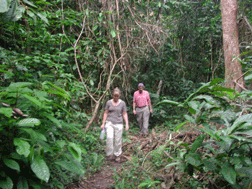 The good news
is that we finally heard and saw monkeys. Early on the trail we heard spot-nosed
monkeys and later we saw three monkeys we couldn’t identify in the trees.
Towards the end, we heard monas and Roloways.
The good news
is that we finally heard and saw monkeys. Early on the trail we heard spot-nosed
monkeys and later we saw three monkeys we couldn’t identify in the trees.
Towards the end, we heard monas and Roloways.
During the walk, we also came into an area with lots of sun and almost no trees. The ground was covered with small shrubs, ferns, and vines. It looked more like a meadow than a rainforest. Looking overhead, we saw the reason for the lack of trees. Power lines were strung through the jungle to bring electricity to Elubo. To put the power lines in, the jungle has to be cut down.
Finally we finished our transect five hours later. While the distance is never far, walking to the end of the transect and back at such a slow pace takes time….but then there isn’t much else to do here.